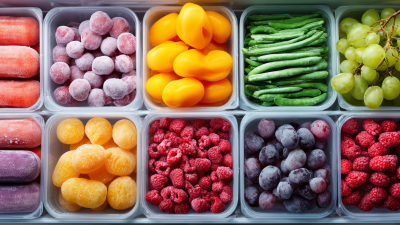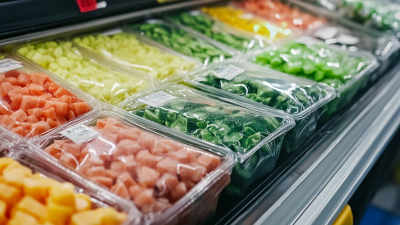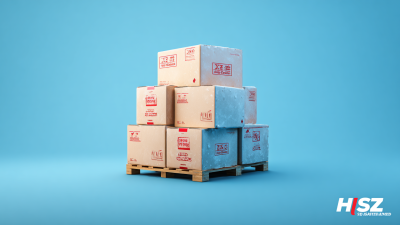Understanding the Science Behind Frozen Food Packaging for Optimal Freshness and Quality
The importance of Frozen Food Packaging cannot be overstated in the modern food distribution landscape, where the global frozen food market is expected to reach a value of approximately $300 billion by 2025 (Mordor Intelligence, 2021). Properly designed packaging plays a crucial role in maintaining the freshness, flavor, and quality of frozen products, which can experience significant changes during storage and transportation. Studies show that inadequate packaging results in up to 30% quality loss in frozen foods due to factors such as moisture loss and exposure to oxygen (Food Quality & Safety, 2020).

By leveraging innovative materials and techniques, manufacturers can enhance the effectiveness of their packaging solutions, ensuring that consumers receive frozen foods that retain their original taste and nutritional value. Understanding the science behind these packaging methods is essential for stakeholders in the food industry who aim to optimize product quality and consumer satisfaction in an increasingly competitive market.
The Importance of Packaging Materials in Preserving Frozen Food Quality
The choice of packaging materials plays a crucial role in maintaining the quality and safety of frozen foods. Various materials, including plastics like Polyethylene (PE) and Polyethylene Terephthalate (PET), are commonly used in the freezing process due to their unique properties that enhance preservation. These materials provide effective barriers against moisture and gases, which are critical factors in preventing freezer burn and maintaining texture and flavor.
As consumer demand for high-quality frozen products continues to rise, the meat and seafood packaging market is projected to grow significantly. With a valuation of approximately $2.01 billion in 2022, it is expected to reach $2.82 billion by 2030, driven by advancements in packaging technologies that extend shelf life and optimize freshness. Innovations in food packaging not only enhance the overall quality of frozen food items but also cater to the increasing preference for convenient and ready-to-eat meal solutions.
Understanding the Role of Temperature Control in Frozen Food Storage
Temperature control is crucial in the storage of frozen foods to maintain their freshness and quality. When food items are frozen, they undergo a process that preserves their nutrients and flavor by slowing down enzyme activity and inhibiting the growth of microorganisms. However, any fluctuation in temperature can lead to ice crystal formation, which may affect texture and taste when the food is thawed. Therefore, ensuring that your freezer maintains a consistent temperature of 0°F (-18°C) or lower is essential.
**Tips**: Regularly check the temperature of your freezer using an appliance thermometer to ensure it remains within the optimal range. Additionally, keep your freezer fully stocked but not overcrowded, as proper air circulation helps maintain an even temperature throughout.
To further enhance the quality of frozen foods, consider using airtight packaging. Vacuum-sealed bags or containers with a tight seal can help prevent freezer burn, which occurs when air comes into contact with the food’s surface. This not only protects the food’s taste and texture but also extends its shelf life.
**Tips**: When repackaging items, remove as much air as possible before sealing. Label packages with the date of freezing to keep track of storage time and ensure you enjoy your foods at their freshest.
Understanding the Role of Temperature Control in Frozen Food Storage
This bar chart illustrates the correlation between storage temperature and food quality in frozen food. As the temperature decreases, maintaining a controlled environment contributes to higher food quality, reaching optimal freshness at -30°C.
Exploring the Impact of Vacuum Sealing on Food Freshness
Vacuum sealing has become a game-changer in food preservation, significantly extending the shelf life of various food items. Unlike traditional storage methods, vacuum-sealed food can last up to five times longer, making it an ideal solution for anyone looking to reduce food waste and maintain freshness. This technology works by removing air from the packaging, thus slowing down the oxidation process and preventing freezer burn. As a result, meats, vegetables, and even delicate items like sliced avocados retain their taste and texture for much longer.
Recent advancements in vacuum sealing technology also highlight its effectiveness in minimizing spoilage, especially for perishable items such as seafood. Innovations in packaging techniques are being rapidly adopted to ensure optimal freshness and quality. Chefs and food enthusiasts alike emphasize the importance of selecting a reliable vacuum sealer to protect their ingredients better. By utilizing the right vacuum sealing method, consumers can not only achieve a clutter-free kitchen but also enjoy delicious, fresh meals without the frequent worry of food spoilage.
Tips for Labeling Frozen Foods for Optimal Freshness Management
When it comes to managing the freshness of frozen foods, proper labeling plays a crucial role. According to a report by the Food Marketing Institute, effective labeling can potentially reduce food waste in households by up to 20%. This is primarily due to clearer information on expiration dates, storage instructions, and safe handling practices. Labels should include not only the packaging date but also the recommended consumption period to ensure that users can enjoy optimal flavor and nutritional benefits.

Moreover, incorporating specific identifiers such as batch numbers and temperature storage guidelines can enhance food safety and quality. The USDA recommends maintaining a consistent freezing temperature of 0°F (-18°C) to preserve the texture and nutritional value of frozen foods. By proactively labeling products with precise storage protocols and visually accessible information, consumers are equipped to make informed decisions, thus maximizing the longevity and enjoyment of their frozen items. Investing time in proper labeling is a simple yet effective strategy for both manufacturers and consumers aiming for sustainability and minimal waste.
Best Practices for Thawing Frozen Foods to Maintain Quality
Thawing frozen foods correctly is crucial for maintaining their quality and safety. According to the U.S. Department of Agriculture, the safest method for thawing is in the refrigerator, as it keeps food at a consistent, safe temperature below 40°F. This method not only prevents the growth of harmful bacteria but also helps to retain the food's texture and flavor. Foods thawed in the refrigerator can remain safe for an additional one to two days before cooking, offering flexibility in meal planning.
 Alternatively, for quicker thawing, the microwave can be used, although it is important to cook the food immediately after thawing to prevent uneven cooking or bacteria growth. A report from the Food and Drug Administration emphasizes that while cold water thawing is also an option, it requires vigilance to ensure the water remains cold and the food is cooked promptly afterward. Maintaining quality during the thawing process hinges on these best practices, ensuring that the nutritional value and taste are preserved, delivering not just convenience but also a healthier dining experience.
Alternatively, for quicker thawing, the microwave can be used, although it is important to cook the food immediately after thawing to prevent uneven cooking or bacteria growth. A report from the Food and Drug Administration emphasizes that while cold water thawing is also an option, it requires vigilance to ensure the water remains cold and the food is cooked promptly afterward. Maintaining quality during the thawing process hinges on these best practices, ensuring that the nutritional value and taste are preserved, delivering not just convenience but also a healthier dining experience.
Related Posts
-

7 Essential Tips for Optimal Frozen Food Packaging Solutions
-

Frozen Food Packaging Innovations Showcased at 2025 China 138th Canton Fair
-

Top 10 Manufacturers of Frozen Food Bags in China at the 137th Canton Fair
-

Top Strategies for Selecting the Most Efficient Frozen Food Shipping Solutions
-

Solutions for Streamlined Frozen Food Shipping Boxes: Boosting Efficiency and Freshness
-

How to Choose the Best Frozen Food Shipping Boxes for Your Business Needs

 中国
中国